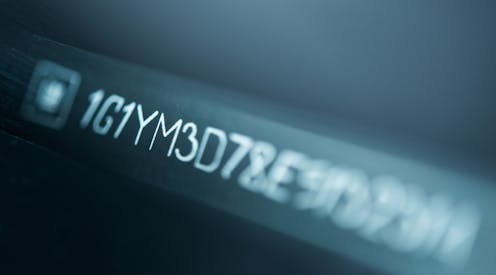A VIN is a unique string of 17 characters assigned to vehicles.
welcomia/iStock via Getty Images Plus
Every vehicle built after 1981 has a unique vehicle identification number, or VIN. The location of this string of letters and numbers varies, but it’s located somewhere on every car, SUV, motorcycle and truck – typically on a small metal plate or a sticker.
VINs serve many purposes. They help consumers learn about a used car’s history, including whether it was stolen, or determine whether rebates for a particular electric vehicle are available. This code appears in the paperwork necessary to do everything from insuring your car to selling it.
I research data standards and became interested in VINs while doing research for my book about the cultural history of barcodes.
Like barcode numbers, a VIN’s characters are standardized. They can tell a story if you know what to look for.
A lot of information is packed into these 17 characters.
The Conversation U.S., CC BY-SA
What VINs can tell you
VINs can convey at least seven pieces of information.
Origin
If a VIN begins with a 1, 4 or 5, that means it’s a vehicle assembled in the U.S. Many other countries have their own unique identifier. A 2, for example, means the vehicle was made in Canada; a J stands for Japan.
Manufacturer
The second and third characters indicate the manufacturer. In some cases, the code corresponds with a line of vehicles that now belongs to a larger corporation. Dodge and Jeep, now part of Stellantis, each has its own. So does Lincoln, which became a division of Ford Motor Co. in 1922.
Description
The fourth through eighth characters provide several details, such as body type and engine type.
Security
The ninth character is a “check digit” determined by a complex mathematical equation based on the rest of the VIN’s numbers and letters. This digit, either a number or the letter X, is used to authenticate that the VIN is not a forgery.
Year
The 10th character indicates the model year. There’s only one slot for this, and not all letters and numbers are used, resulting in repetition. An R could signal either 2024 or 1994, for example.
Factory
The 11th character indicates the specific plant where the vehicle was assembled.
Serial number
The VIN’s final six characters compose a serial number that differentiates the vehicle from all others made in the same factory that are the identical type and model year.
Vehicle identification number locations vary but are generally found in one of four places.
The Conversation U.S., CC BY-SA
Finding more information
Only experts can tell where a vehicle was assembled or what type of engine it has by looking at its VIN. But help is available.
The National Highway Traffic Safety Administration provides a handy VIN decoder. When I plugged my vehicle’s VIN into the decoder, the site correctly determined that my SUV is a 2011 Subaru Forester with an automatic transmission.
Of course, I already knew all that.
What I didn’t realize was that it weighs between 4,000 and 5,000 pounds, has a 2.5-liter engine and features side curtain airbags to protect the driver and passengers in the front and back seats. I also learned that this Subaru Forester was assembled in Gunma, Japan.
Those details had been invisible to me as a consumer, but they had been within easy reach ever since I bought my Forester in 2018. I had somehow driven that car well over 100,000 miles without realizing the number on the side of my driver’s seat contained some history.
Before buying the Forester, even though I didn’t know that my VIN could say so much, I did run it through a free online system to make sure it hadn’t been stolen.
To be sure, VINs won’t tell you everything you might want to know about a vehicle, such as what color it was when it rolled off the line. But if you can do a little decoding and make use of widely available online tools, they do harbor important information.
Where’s your VIN and what’s it for?
Jordan Frith does not work for, consult, own shares in or receive funding from any company or organization that would benefit from this article, and has disclosed no relevant affiliations beyond their academic appointment.













